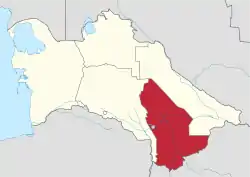Mary Region
Mary Region (Turkmen: Mary welaýaty, Мары велаяты) is one of the regions of Turkmenistan. It is located in the south-east of the country, bordering Afghanistan. Its capital is the city of Mary. Its area is 87,150 km2 (33,650 sq mi) and population 1,480,400 (2005 est.).[1] The average population density is about 15 persons per square kilometer, but it reaches 150-200 per square kilometer in the most developed oases.
Mary | |
|---|---|
 Mary region in Turkmenistan | |
| Country | |
| Capital | Mary |
| Area | |
| • Total | 87,150 km2 (33,650 sq mi) |
| Population (2005) | |
| • Total | 1,480,400 |
| • Density | 17/km2 (44/sq mi) |
In 2000, Mary Region accounted for 23% of Turkmenistan's population, 19% of the total number of employed, 26% of agricultural production (by value), and 21% of the country's total industrial production.[2] The region's industries include natural gas extraction (the Iolotan gas field), electric power generation, textiles, carpet weaving, chemical and food industry. In 2001 it accounted for 74% of Turkmenistan's electricity generation 26% of natural gas extraction.[3]
Agriculture in Mary Region is irrigated by the Karakum Canal, which runs east to west through the center of the province, and by the Murghab River, which runs south to north, entering the province from Afghanistan. While the northern portion of the province is within the Central Asian southern desert ecoregion, the southern portion of the province is characterized by a savanna of pistachio and desert sedges, classified as the Badkhiz-Karabil semi-desert by the World Wildlife Fund.[4]
Ancient Merv, designated a UNESCO World Heritage Site, is the main archeological attraction of Mary Province. This is one of the best preserved oasis cities on the ancient silk route.[5]
The capital of Mary Region is the city of Mary, located at the intersection of Murghab River with the Karakum Canal. Other major cities are Baýramaly (Russian: Байрам-Али), Ýolöten (Iolotan, Russian: Иолотань), and Serhetabat (Russian: Серхетабад, formerly Turkmen: Guşgy, Russian: Кушка) on the border with Afghanistan.
Districts
As of January 1, 2017, Mary Province (Mary welaýaty) is subdivided into 11 districts (Turkmen: etrapy; etraplar (plural)):[6][7]
- Baýramaly District
- Garagum District
- Mary District
- Murgap District
- Oguzhan District
- Sakarçäge District
- Serhetabat District (formerly Guşga or Kuşka)
- Tagtabazar District
- Türkmengala District
- Wekilbazar District
- Ýolöten District
As of January 1, 2017, the province includes 8 cities (города or şäherler), 14 towns (посёлки or şäherçeler), 143 rural or village councils (сельские советы or geňeşlikler), and 329 villages (села, сельские населенные пункты or obalar).[7][6]
- Cities include:
- Baýramaly
- Mary
- Murgap
- Sakarçäge
- Şatlyk
- Serhetabat (formerly Guşga or Kuşka)
- Türkmengala
- Ýolöten
References
- Statistical Yearbook of Turkmenistan 2000-2004, National Institute of State Statistics and Information of Turkmenistan, Ashgabat, 2005.
- Social-economic situation of Turkmenistan in 2000, National Institute of State Statistics and Information of Turkmenistan, Ashgabat, 2001, pp. 137-138 (in Russian).
- Social-economic situation of Turkmenistan in 2001, National Institute of State Statistics and Information of Turkmenistan, Ashgabat, 2002, pp. 107-109 (in Russian).
- World Wildlife Fund, ed. (2001). "Badkhiz-Karabil semi-desert". WildWorld Ecoregion Profile. National Geographic Society. Archived from the original on 2010-03-08. Retrieved 2012-08-05.
- Bonneville, Patrick and Hemono, Philippe. 2006. The World Heritage. Bonneville Connection, Quebec
- Türkmenistanyň Mejlisi (2010–2018). "Türkmenistanyň dolandyryş-çäk birlikleriniň Sanawy". Türkmenistanyş Mejlisiniň Karary. Ashgabat. This document is reproduced online at https://wiki.openstreetmap.org/wiki/Districts_in_Turkmenistan.
- "Административно-территориальное деление Туркменистана по регионам по состоянию на 1 января 2017 года". Archived from the original on 2018-07-08. Retrieved 2018-07-08.
